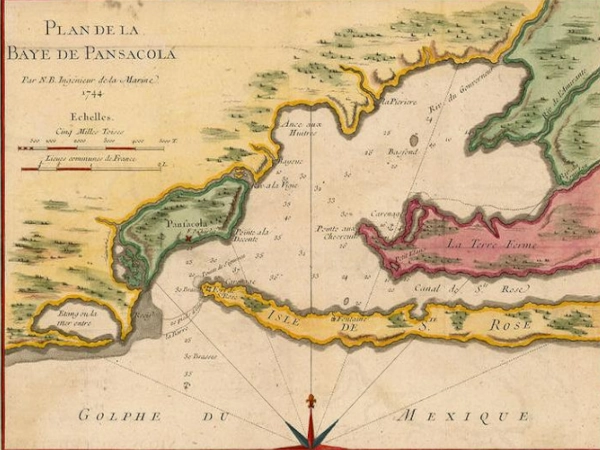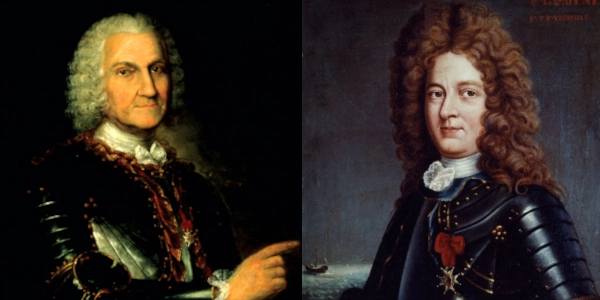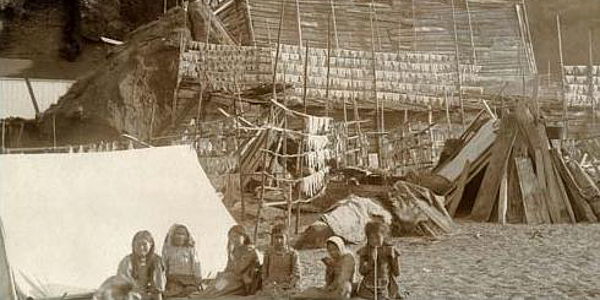Sponsor this page. Your banner or text ad can fill the space above.
Click here to Sponsor the page and how to reserve your ad.
-
Timeline
1719 Detail
May 14, 1719 - French soldier Bienville attacks and captures Pensacola after the War of the Quadruple Alliance is declared between France and Spain.

Jean-Baptiste le Moyne, Sieur de Bienville, Governor of Louisiana, and French soldier, had been one busy man ever since he and his brother, Pierre Le Moyne d'Iberville, had come on an expedition in 1698 to found the New France colonies in Mississippi, Alabama, and Louisiana. New Orleans had just been founded in 1718, others as well beyond the firsts in Biloxi and Mobile. But, boy, had his brother, now deceased, loved the port of Pensacola when they had stopped there briefly on their way to establish their colonies west along the Gulf of Mexico. He had rued that their late start had allowed the Spanish to build their forts and settlement at Pensacola, known as Santa Maria de Galve at the time, just months before they arrived. "... This (Pensacola) is certainly a most beautiful port equal at least to that of Brest, and has been lost to us by delay," d'Iberville.
But now, there was war in continental Europe that had muddied things in the colonial world. The War of the Quadrupal Alliance, a mouthful, had begun on August 18, 1718, and would last for two years. Its genesis was the Spanish attempting to recover territories in Italy, i.e. Sicily, it has lost in the 1713 Treaty of Ultrecht that ended Queen Anne's War. Spain had captured Sardinia, caused an uprising in Scotland, and caused engagements in Northern Europe and the Americas. Who made up the Quadruple Alliance against Spain; England, France, Austria, and the Dutch Republic.
Bienville Attacks Pensacola
The war had been going on for seven months by the time Bienville got the news from passengers on the ship Comte de Toulouse in March. He wondered whether that news had reached Pensacola and whether a surprise attack would have a great chance of success. There were also reports that the Spanish were going to attack the British settlements in South Carolina, and Bienville was concerned that the Spanish might go the other direction and attack Mobile.
A quick council meeting agreed with Bienville that an attack should be made. With twenty men, Bienville sailed up the Perdido River from Mobile and met with a disorganized group of eight hundred recruits, which included soldiers and citizens, plus four hundred Indian allies. They marched overland toward Pensacola. Meanwhile, Bienville had instructed Serigny, known as Joseph Le Moyne de Sérigny et de Loire, his brother and joint commander of the colony since 1718, to sail from Dauphin Island with three man-of-war vessels, the Phillippi and Toulouse, with twenty-four guns apiece, and another ship, the Mareschal de Villars, in all carrying one hundred and fifty sailors.
The three ships and Bienville's army arrived at the same time, completely surrounding Pensacola by sea and land. With only a few skirmish shots and no all out battle, the Governor of Pensacola, Don Juan Pedro Matamoros, surrendered. All seemed to have gone well for the French, but Bienville, after victory, made a mistake. He sent the men from the Spanish garrison back to Spanish Cuba on the Mareschal de Villars and Toulouse. However, the Spanish Governor in Cuba did not just accept the prisoners back; he attacked the two French ships and seized its crew.
The two French ships were manned with Spanish soldiers and accompanied by nine brigantines, a man-of-war, and eighteen hundred men. They returned to Pensacola on August 6, 1719 to retake the city. Bienville had already returned to Mobile, leaving another brother Chateaugue in charge at Pensacola. When the French saw the approaching flotilla, fifty French soldiers joined the Spanish, forcing Chateaugue to surrender. But the Spanish were not done yet. They sent two brigantines to Dauphin Island in Mobile Bay to attack and capture it. Brother Serigny was there with the ship Phillippi; he refused their offer of surrender and decided to fight.
Thirty-five men were sent off a Spanish ship onto Mon Luis Island, halfway between Dauphin Island and the city of Mobile. They destroyed the villages there, but were met by Canadians and Indians sent from Mobile by Bienville to thwart their advance. They did, capturing and killing most of the soldiers, including those who had deserted, while other Spanish soldiers drowned trying to swim back to their ship.
Two days later, a Spanish squadron returned to Dauphin Island and attacked the Phillippi and fort. Serigny, with a force of one hundred and sixty soldiers and two hundred Indian allies returned fire. For four days the two sides bombarded each other, but the French soldiers held the fort. The Spanish returned to Pensacola.
The Aftermath
There was unease on the Gulf Coast after the Spanish had left, but that feeling was cut short, at least for a moment, when five ships from France under the command of Champmeslin arrived in Mobile Bay in September. The Spanish brigantines, still patrolling around Dauphin Island and Mobile Bay saw the reinforcements and quickly returned to Pensacola.
Bienville and Serigny boarded the ships of Champmeslin and held a council of war. They decided to attack Pensacola again. The new five ships, plus the Phillippi and Union, with two hundred and fifty new troops, joined the flotilla as they sailed toward Pensacola several days later. Bienville led his men on the same successful path as in May, up the Perdido River to meet five hundred Indian allies.
Champmeslin and his ships, plus a sixth, the Hercules with sixty-four guns, pushed past the sand bar, and opened fire on the Spanish ships on September 12, their two forts of San Carlos and Fort Siguenza at the west end of Santa Rosa Island, and a new gun battery. After four hours, the Spanish surrendered. Meanwhile, Bienville attacked the rear of the fort with his men; their first charge repulsed. Before his second charge could commence, the flag of surrender was flown. The French were again in command of Pensacola on September 19, 1719 with the booty of four ships and six brigantines. The French would remain in charge of the battered city for less than three months.
Bienville and Champmeslin exchanged three hundred and sixty prisoners for those held by the Spanish in Cuba, and an uneasy lull quieted the Gulf of Mexico until the War of the Quadruple Alliance was over in 1720, both sides always wary of another attack. The treaty forced the French to give back Pensacola to the Spanish in exchange for commercial concessions.
Image above: Drawing of the port of Pensacola, 1744, Narcise Broutin. Courtesy Wikipedia Commons. Image Below: Montage (left) Painting of Jean-Baptiste Le Moyne de Bienville, unknown date or author. Courtesy Wikipedia Commons; (right) painting of his brother, Pierre Le Moyne d'Iberville, unknown date and author. Courtesy Wikipedia Commons. Info Source: "Dauphin Island, AL, French Possession 1699-1763, Bienville Takes Pensacola, 1719," Joe Myrtle Kennedy, dauphinislandhistory.com; "Imperial Rivalries," Library of Congress; "Appleyard; French flag flew over Pensacola, Briefly," 2018, John Appleyard, Pensacola News Journal; Encyclopedia of Alabama; Wikipedia Commons.

History Photo Bomb

Jean-Baptiste le Moyne, Sieur de Bienville, Governor of Louisiana, and French soldier, had been one busy man ever since he and his brother, Pierre Le Moyne d'Iberville, had come on an expedition in 1698 to found the New France colonies in Mississippi, Alabama, and Louisiana. New Orleans had just been founded in 1718, others as well beyond the firsts in Biloxi and Mobile. But, boy, had his brother, now deceased, loved the port of Pensacola when they had stopped there briefly on their way to establish their colonies west along the Gulf of Mexico. He had rued that their late start had allowed the Spanish to build their forts and settlement at Pensacola, known as Santa Maria de Galve at the time, just months before they arrived. "... This (Pensacola) is certainly a most beautiful port equal at least to that of Brest, and has been lost to us by delay," d'Iberville.
But now, there was war in continental Europe that had muddied things in the colonial world. The War of the Quadrupal Alliance, a mouthful, had begun on August 18, 1718, and would last for two years. Its genesis was the Spanish attempting to recover territories in Italy, i.e. Sicily, it has lost in the 1713 Treaty of Ultrecht that ended Queen Anne's War. Spain had captured Sardinia, caused an uprising in Scotland, and caused engagements in Northern Europe and the Americas. Who made up the Quadruple Alliance against Spain; England, France, Austria, and the Dutch Republic.
Bienville Attacks Pensacola
The war had been going on for seven months by the time Bienville got the news from passengers on the ship Comte de Toulouse in March. He wondered whether that news had reached Pensacola and whether a surprise attack would have a great chance of success. There were also reports that the Spanish were going to attack the British settlements in South Carolina, and Bienville was concerned that the Spanish might go the other direction and attack Mobile.
A quick council meeting agreed with Bienville that an attack should be made. With twenty men, Bienville sailed up the Perdido River from Mobile and met with a disorganized group of eight hundred recruits, which included soldiers and citizens, plus four hundred Indian allies. They marched overland toward Pensacola. Meanwhile, Bienville had instructed Serigny, known as Joseph Le Moyne de Sérigny et de Loire, his brother and joint commander of the colony since 1718, to sail from Dauphin Island with three man-of-war vessels, the Phillippi and Toulouse, with twenty-four guns apiece, and another ship, the Mareschal de Villars, in all carrying one hundred and fifty sailors.
The three ships and Bienville's army arrived at the same time, completely surrounding Pensacola by sea and land. With only a few skirmish shots and no all out battle, the Governor of Pensacola, Don Juan Pedro Matamoros, surrendered. All seemed to have gone well for the French, but Bienville, after victory, made a mistake. He sent the men from the Spanish garrison back to Spanish Cuba on the Mareschal de Villars and Toulouse. However, the Spanish Governor in Cuba did not just accept the prisoners back; he attacked the two French ships and seized its crew.
The two French ships were manned with Spanish soldiers and accompanied by nine brigantines, a man-of-war, and eighteen hundred men. They returned to Pensacola on August 6, 1719 to retake the city. Bienville had already returned to Mobile, leaving another brother Chateaugue in charge at Pensacola. When the French saw the approaching flotilla, fifty French soldiers joined the Spanish, forcing Chateaugue to surrender. But the Spanish were not done yet. They sent two brigantines to Dauphin Island in Mobile Bay to attack and capture it. Brother Serigny was there with the ship Phillippi; he refused their offer of surrender and decided to fight.
Thirty-five men were sent off a Spanish ship onto Mon Luis Island, halfway between Dauphin Island and the city of Mobile. They destroyed the villages there, but were met by Canadians and Indians sent from Mobile by Bienville to thwart their advance. They did, capturing and killing most of the soldiers, including those who had deserted, while other Spanish soldiers drowned trying to swim back to their ship.
Two days later, a Spanish squadron returned to Dauphin Island and attacked the Phillippi and fort. Serigny, with a force of one hundred and sixty soldiers and two hundred Indian allies returned fire. For four days the two sides bombarded each other, but the French soldiers held the fort. The Spanish returned to Pensacola.
The Aftermath
There was unease on the Gulf Coast after the Spanish had left, but that feeling was cut short, at least for a moment, when five ships from France under the command of Champmeslin arrived in Mobile Bay in September. The Spanish brigantines, still patrolling around Dauphin Island and Mobile Bay saw the reinforcements and quickly returned to Pensacola.
Bienville and Serigny boarded the ships of Champmeslin and held a council of war. They decided to attack Pensacola again. The new five ships, plus the Phillippi and Union, with two hundred and fifty new troops, joined the flotilla as they sailed toward Pensacola several days later. Bienville led his men on the same successful path as in May, up the Perdido River to meet five hundred Indian allies.
Champmeslin and his ships, plus a sixth, the Hercules with sixty-four guns, pushed past the sand bar, and opened fire on the Spanish ships on September 12, their two forts of San Carlos and Fort Siguenza at the west end of Santa Rosa Island, and a new gun battery. After four hours, the Spanish surrendered. Meanwhile, Bienville attacked the rear of the fort with his men; their first charge repulsed. Before his second charge could commence, the flag of surrender was flown. The French were again in command of Pensacola on September 19, 1719 with the booty of four ships and six brigantines. The French would remain in charge of the battered city for less than three months.
Bienville and Champmeslin exchanged three hundred and sixty prisoners for those held by the Spanish in Cuba, and an uneasy lull quieted the Gulf of Mexico until the War of the Quadruple Alliance was over in 1720, both sides always wary of another attack. The treaty forced the French to give back Pensacola to the Spanish in exchange for commercial concessions.
Image above: Drawing of the port of Pensacola, 1744, Narcise Broutin. Courtesy Wikipedia Commons. Image Below: Montage (left) Painting of Jean-Baptiste Le Moyne de Bienville, unknown date or author. Courtesy Wikipedia Commons; (right) painting of his brother, Pierre Le Moyne d'Iberville, unknown date and author. Courtesy Wikipedia Commons. Info Source: "Dauphin Island, AL, French Possession 1699-1763, Bienville Takes Pensacola, 1719," Joe Myrtle Kennedy, dauphinislandhistory.com; "Imperial Rivalries," Library of Congress; "Appleyard; French flag flew over Pensacola, Briefly," 2018, John Appleyard, Pensacola News Journal; Encyclopedia of Alabama; Wikipedia Commons.

History Photo Bomb
There was unease on the Gulf Coast after the Spanish had left, but that feeling was cut short, at least for a moment, when five ships from France under the command of Champmeslin arrived in Mobile Bay in September. The Spanish brigantines, still patrolling around Dauphin Island and Mobile Bay saw the reinforcements and quickly returned to Pensacola.
Bienville and Serigny boarded the ships of Champmeslin and held a council of war. They decided to attack Pensacola again. The new five ships, plus the Phillippi and Union, with two hundred and fifty new troops, joined the flotilla as they sailed toward Pensacola several days later. Bienville led his men on the same successful path as in May, up the Perdido River to meet five hundred Indian allies.
Champmeslin and his ships, plus a sixth, the Hercules with sixty-four guns, pushed past the sand bar, and opened fire on the Spanish ships on September 12, their two forts of San Carlos and Fort Siguenza at the west end of Santa Rosa Island, and a new gun battery. After four hours, the Spanish surrendered. Meanwhile, Bienville attacked the rear of the fort with his men; their first charge repulsed. Before his second charge could commence, the flag of surrender was flown. The French were again in command of Pensacola on September 19, 1719 with the booty of four ships and six brigantines. The French would remain in charge of the battered city for less than three months.
Bienville and Champmeslin exchanged three hundred and sixty prisoners for those held by the Spanish in Cuba, and an uneasy lull quieted the Gulf of Mexico until the War of the Quadruple Alliance was over in 1720, both sides always wary of another attack. The treaty forced the French to give back Pensacola to the Spanish in exchange for commercial concessions.
Image above: Drawing of the port of Pensacola, 1744, Narcise Broutin. Courtesy Wikipedia Commons. Image Below: Montage (left) Painting of Jean-Baptiste Le Moyne de Bienville, unknown date or author. Courtesy Wikipedia Commons; (right) painting of his brother, Pierre Le Moyne d'Iberville, unknown date and author. Courtesy Wikipedia Commons. Info Source: "Dauphin Island, AL, French Possession 1699-1763, Bienville Takes Pensacola, 1719," Joe Myrtle Kennedy, dauphinislandhistory.com; "Imperial Rivalries," Library of Congress; "Appleyard; French flag flew over Pensacola, Briefly," 2018, John Appleyard, Pensacola News Journal; Encyclopedia of Alabama; Wikipedia Commons.





